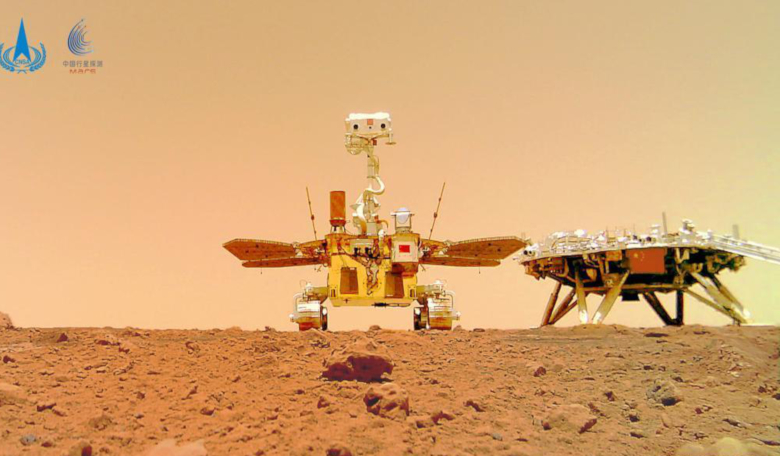Its a busy week for China as the nation not only releases its first pictures of Mars taken by Zhurong, the country's first martian rover, but also gears up to send three astronauts to its orbiting space station in the coming days.
At a ceremony in Beijing today, Zhang Rongqiao, chief designer of China's first Mars exploration mission unveiled four new images of Mars that include the landing site panorama, the martian landscape and a selfie of the rover with the landing platform.
Along with tracks made by Zhurong on the surface that can be clearly seen, a fabric Chinese national flag and a monochromic drawing of mascots of the Beijing 2022 Winter Olympics and Paralympic Winter Games are also noticeable in the pictures.
As of Friday, Zhurong has been working on the Red Planet for 28 Martian days to carry out scientific exploration.
Meanwhile, earlier in the week, a Long March 2F rocket was vertically transferred to its pad at the Jiuquan Satellite Launch Center in the Gobi Desert, say officials at the China Manned Space Engineering Office (CMSEO).
The Long March will loft the Shenzhou-12 spacecraft into a low-Earth orbit where it will rendezvous and dock with the Tianhe space station module.
Three taikonauts, the name for Chinese astronauts, are expected to be on board, although authorities have yet to reveal the primary and backup crews for the mission.
Shenzhou-12 will be China’s first crewed mission in more than four years. It is unclear how long the mission will last – timescales of one to three months have been suggested – but the taikonauts will likely test systems and prepare for the arrival of the next modules.
The spacecraft was initially rumoured to launch around 10 June, but delays to the launch of the nation’s Tianzhou-2 cargo mission last month suggests that liftoff for the Long March could also be deferred for a week reports SpaceNews.
Tianzhou-2 docked with Tianhe at the end of May to automatically deliver supplies, equipment and propellant for the upcoming crewed Shenzhou-12 mission.
Both the core module and cargo craft are equipped with independent power supply systems, but after docking, the two systems can form a connected grid to share electric power.
"The two independent systems work like two smartphones," said Yu Lei, an engineer in charge of power supply to the Tianzhou-2 project. "They can undergo both separate and mutual charging."
Tianhe, the core module, is powered by solar panels less than one millimetre thick that can be repeatedly folded and unfolded.
The panels have a combined collecting area of 80 square metres - enough to provide up to 20 KW of power to the core module, said Yu Hui, designer of the solar panels in a report published by Xinhua News Agency.
Researchers estimate that it takes 91 minutes for the space station to go around our planet in low-Earth orbit, during which time it can receive sunlight for about 54 minutes. This means the solar panels experience the light-shade cycle about 16 times every day.
China aims to complete the construction of its space station, a structure that will be around 1/5 the mass of the International Space Station, by the end of 2022.











